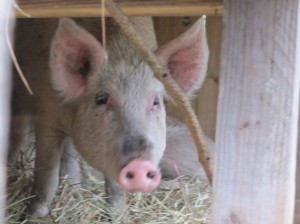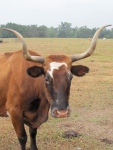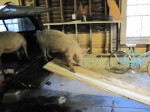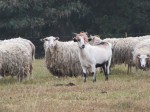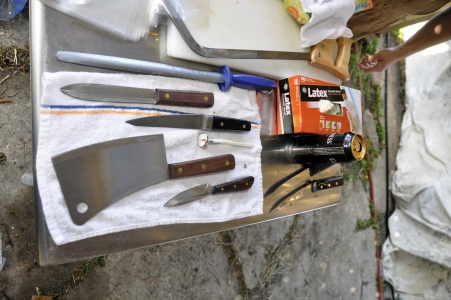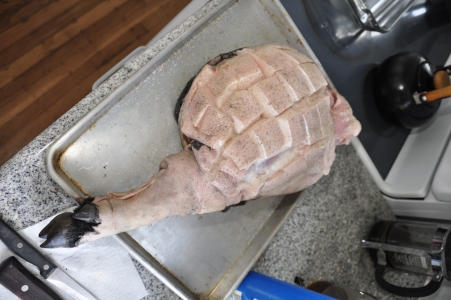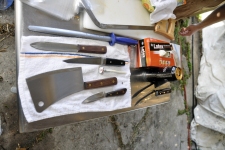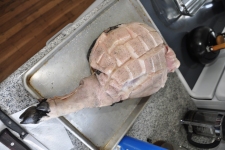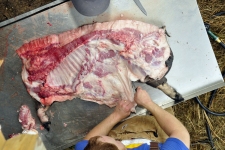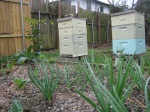
If a fortune teller had at any point in my childhood told me that I would 1. live in the South, and 2. raise pigs, I might have screamed and run. But here I am doing and relishing both.
This time around, my second foray into hog farming, I got big pigs. I loved the guinea hogs and how friendly they were, and the tasty meat and lard they produced. I still think that guinea hogs are the best pig overall for urban farming/homesteading because they are small, mellow, they’re an endangered heritage breed and they thrive on minimal amounts of food. The problem is that I have access to lots of food waste, since I work in a restaurant and cheese shop, and the guinea hogs couldn’t keep up. The guinea hogs tried valiantly to eat everything I brought them, but they couldn’t and they just put on straight fat and not much meat. By the end of March last year, they were definitely obese and it felt wrong, not really fair to the pigs, and I felt like I was practicing slightly irresponsible farming. I think they were happy pigs: they certainly never knew hunger and they got to forage and graze in addition to their rich diet of cheese and bread. They also got daily massages with a metal rake, which I have no doubt contributed to their overall well-being.
While lard is delicious, better for you than butter, and useful for making soap, I want to experiment with pigs who can eat a lot of food waste and turn it into a lot of meat. Which is what led me to Mississippi in the picture at the top.
I bought two feeder pigs from Justin Pitts, a Mississippi farmer of some fame in certain circles because of the heritage breed livestock he raises. The Piney Woods cattle, pictured at top and in the gallery, are a rare breed native to the Gulf region that descends from stock brought over by the Spanish conquistadors. They are particularly hardy, heat tolerant and resistant to parasites. Pitts’ cattle are a prized family heirloom and their lineage can be traced back over 150 years (after 150 years the records are lost). His animals are like a living museum: Piney woods cattle, Gulf Coast Sheep, Spanish goats and Cotton Patch Geese are all breeds that are unique to the United States, and are in danger of extinction. Visit the American Livestock Breeds Conservancy website for more information on the endangered breeds Pitts raises.


Many of the animals are descended from Spanish stock, and the Cotton patch geese have the unique claim to fame of helping families survive the Great Depression by providing meat, eggs, and grease with minimal feed. Most people don’t think of livestock as something that could go extinct, but these are dual purpose breeds that fell out of favor when agriculture became industrialized–instead of using animals that were good at producing multiple products, farmers switched to breeds that produced a lot of just one thing. Justin Pitts himself is a rare breed: a reticent Southern farmer of Scotch and Choctaw descent who continues to raise old breeds and laments the way the world is now.
Last week, on ‘pig day’, as we pulled up to the gate at Pitts farm, we were met by a bunch of beautiful spotted cows out on the road browsing on vines and foraging waist high in the neighbor’s field. We called Justin Pitts and he drove out to meet us and collect his cows.
When he rolled down the window of his truck, he bellowed out a cow-call of some sort and all the cows moo-ed in response–not a typical farmer/cow relationship. In fact, once all the cows were back in the right place, as we stood in the pasture talking about the stock, some of the cows appeared to be listening in on the conversation. I don’t mean from a distance, I mean two of the cows stood a human-distance away, watching us, closing the circle that included the four of us humans. We listened to Pitts’ story of their lineage, while the cows gave their approval of the tale, chewing repetitively.

Then we moved on to pig collecting/wrangling. The pigs are a pretty standard breed, a Yorkshire cross. They are currently very skittish–they had never been off the Mississippi farm before and suddenly they were picked up and shoved in the back of a truck and driven for two hours. Pigs have horrible motion sickness (who knew?) and one of them spent most of the ride heaving and throwing up in the back. Now they are settled in, rooting up the backyard, and just generally making my life more interesting: daily bike rides with a five gallon bucket of slop fastened to the back. I feel like my life is back in order.
